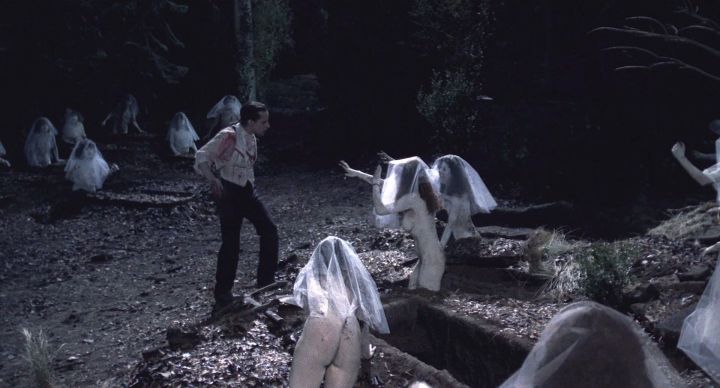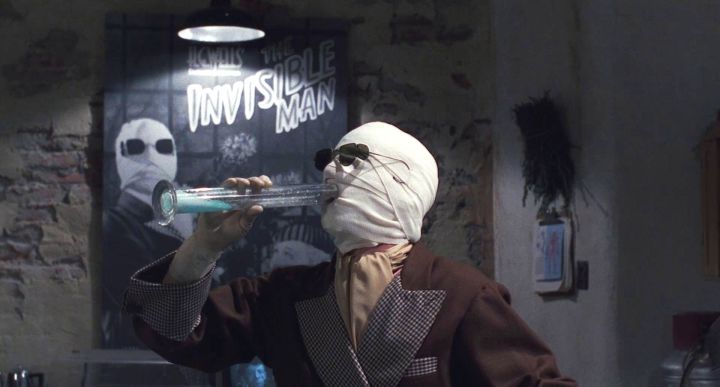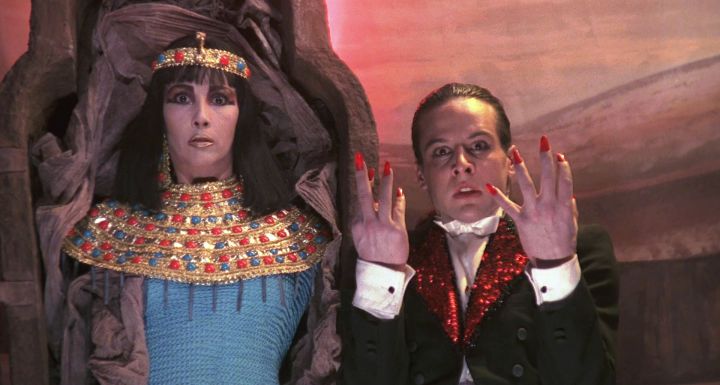Just what one is supposed to make of Santa Sangre is anybody’s guess. Yes, I know, you can say that about most of Jodorowsky’s films. The difference here is that Santa Sangre verges on — dare I suggest it? — the comprehensible. Oh, it has no shortage of Jodorowskyisms, but it ultimately has a story that actually more or less hangs together. Note the use of the word “ultimately.” The first part of the film — following a prologue that sets up the latter part of the story — is mostly typical (if that word can be used) of the filmmaker. Such things as the jerry-built “church” run by Concha (Blanca Guerra), the dying elephant, the elephant funeral, and the business of the poor eating the elephant’s corpse have little place anywhere but in a Jodorowsky film — though the church business with its veneration of an armless “saint” does prove central to the story.
At the same time, the set-up of the triangle involving Concha, her philandering circus owner husband Orgo (Guy Stockwell), and the circus’ Tattooed Woman (Thelma Tixou) — not to mention the key element of young Fenix (Adan Jodorowsky) witnessing all this — is pretty straightforward. In fact, it’s the sort of thing that would do for the basic plot of a Tod Browning silent film of the sideshow melodrama stripe. That Browning probably — even were such things possible at the time — would not have included Orgo’s hydrochloric-acid-to-the-genitals comeuppance or the graphic removal of Concha’s arms are really surface details.
By the time the film returns to the adult Fenix (Axel Jodorowsky) and his escape from a lunatic asylum (where he’s apparently been ever since the events described above), Santa Sangre is transforming itself into something not all that far removed from the Italian giallo — specifically the kind made by Dario Argento. (Bear in mind that the film was co-written and produced by Argento’s brother.) It delivers many of the same shocks and gory killings, but with considerably more depth, more point, and doses of intentional humor — as well as a greater sense of German Expressionist film and classic Hollywood horror. (Consider Fenix’s obsession with James Whale’s 1933 The Invisible Man.)
But perhaps the most interesting thing is that — for all its surrealism — Santa Sangre tells a much clearer story with better dramatic construction than just about anything Argento ever made. It also has greater emotional resonance. There’s something ironic and fascinating that a bona fide surrealist should trump a commericial filmmaker in these areas. More to the point, it raises questions about just how “incomprensible” surrealism really is.










This is indeed going on tonight — for those who want to brave the elements.
I’m not sure what to think of it. But it’s sure worth a view. I’d have to watch it a couple of more times to really come up with much of an opinion on it. I’m glad I saw it though. At the least it sets movie insanity at a fairly high and difficult to equal level.
Have you seen The Last Circus?
No sir, I haven’t Probably worth a try, eh? I do have a like for the bizarre.
It is certainly bizarre. I suspect it’s deeper than we can quite grasp, since we didn’t live through Franco and have (generally speaking) scanty knowledge of Spanish pop culture. It is definitely worth a look — maybe two.
Did you hear about his next film Endless Poetry?
“Alejandro Jodorowsky, father of the midnight movie, wants to exchange your money into Poetic Money to make his latest film.”
It’s on Kickstarter right now.
https://www.kickstarter.com/projects/276667448/jodorowskys-new-film-endless-poetrypoesia-sin-fin